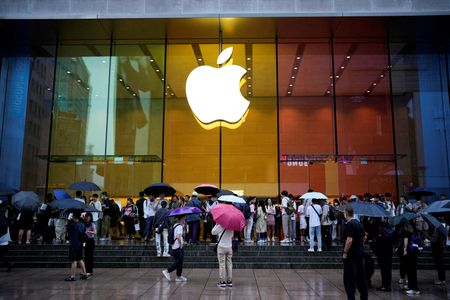By Yuvraj Malik
(Reuters) – Apple investors will have one big question when the world’s most valuable company reports earnings on Thursday – will Huawei’s resurgence in China dampen its holiday-quarter expectations?
The company, which will post results for the July-September period, is grappling with an uneven recovery in the world’s second-largest economy and tougher competition from Huawei after the Chinese firm’s new Mate 60 Pro series phones saw strong early sales.
Apple’s own iPhone 15 line-up has gotten off to a slow start in the crucial international market. Counterpoint estimates China sales of the latest series were nearly 5% lower compared with the iPhone 14 in the first 17 days after launch.
“Strength of the iPhone 15 cycle is the key question heading into the December quarter,” Bernstein analysts said, adding that they expected “muted” sales of the device due to a lack of new features, strained consumer spending and competition from Huawei.
Huawei sold 1.6 million units of its Mate 60 Pro in six weeks, and brokerages such as Jefferies have said the firm could take back much of the market share in the coming years it lost to Apple after U.S. sanctions in 2019 hammered its business.
Those fears, as well as a wider pullback in tech stocks due to high interest rates, knocked Apple shares down nearly 14% in the three months to October-end, compared with the tech-heavy Nasdaq’s 11% decline in the same period.
But there are signs of an economic pick up in China. Data released last month showed the economy grew at a faster-than-expected clip of 4.9% in the third quarter – though less than the 6.3% expansion in the second quarter – while consumption and industrial activity also surprised on the upside in September.
The July-September period marks Apple’s fiscal fourth quarter, and the company is expected to lay down a percentage target for sales growth for the October-December period – its fiscal first quarter that covers holiday-season shopping.
Wall Street analysts expect iPhone sales to rise about 6% in the October-December period, according to LSEG data. That is well below historical levels – barring 2022’s holiday season quarter when Chinese COVID-19 curbs curtailed production of high-end iPhones, the average holiday quarter sales growth for the device has been 9.2% in the past four years.
However, the fiscal first-quarter projections suggest an improvement from an estimated increase of 2.8% for the three months ended September, marking the largest rise in iPhone sales since the start of this year.
Overall revenue is still expected to tick down nearly 1%, dragged by continued weakness in sales of the iPad and Mac, which are expected to fall 15% and 25%, respectively.
Apple earlier this week unveiled new MacBook Pro and iMac computers and three new chips to power them. The machines aimed at professional users, come at a time when the PC market is showing signs of a pick up after its over two-years-long slump.
The decline in global PC shipments slowed for a third straight quarter in the July-September period, a sign that the market has bottomed out, according to research firm IDC.
The global smartphone market contracted 8% in this period, according to Counterpoint.
The company’s services business will likely be a bright spot, with estimated growth of 11.3%. The segment has often outpaced growth in Apple’s hardware business in recent years and now accounts for nearly a quarter of its total revenue.
(Reporting by Yuvraj Malik in Bengaluru, Writing by Aditya Soni; Editing by Saumyadeb Chakrabarty)

